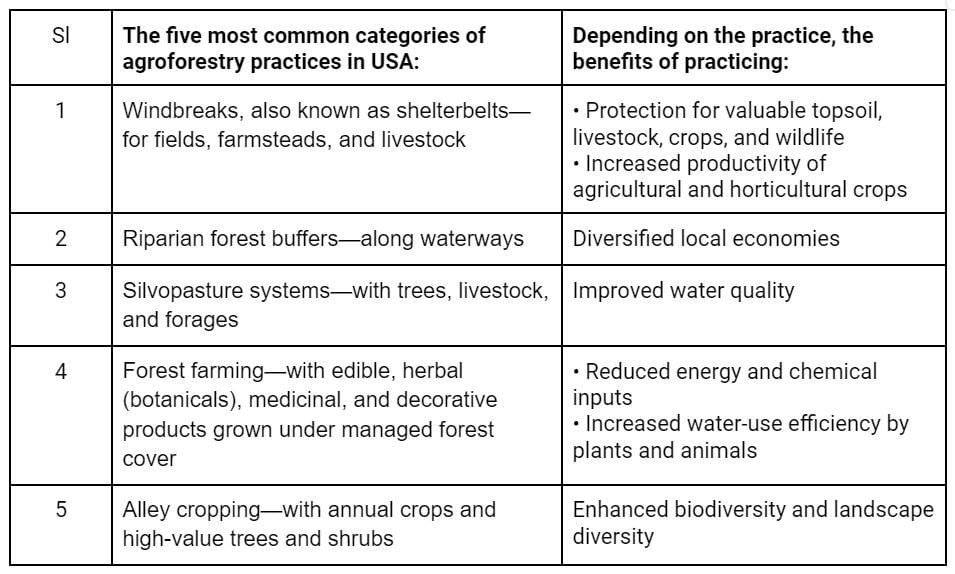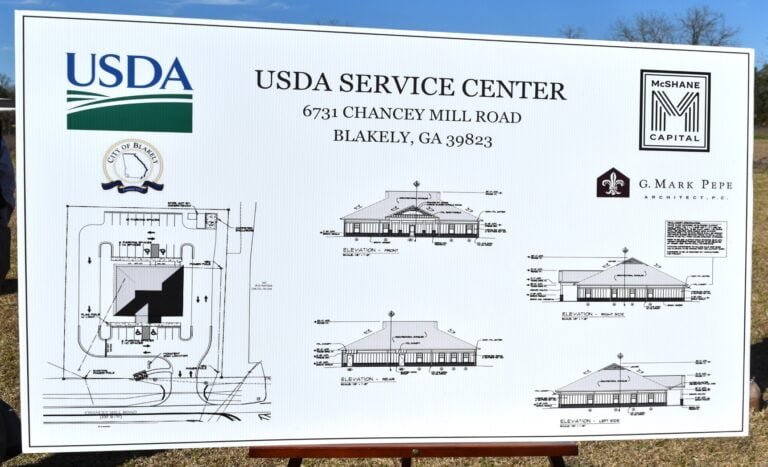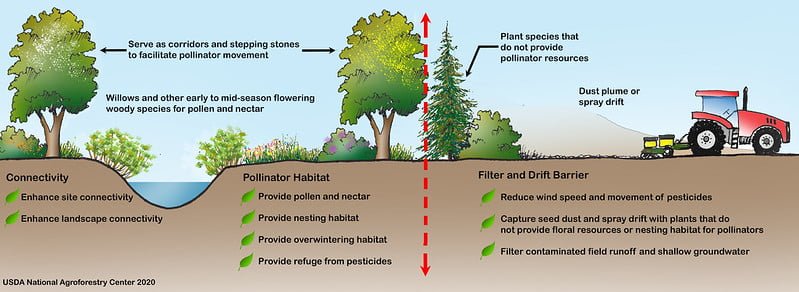USDA Purposes On Agroforestry Strategic Framework

Introduction
Agroforestry, therefore, integrates trees with crops and livestock, offering environmental, economic, and social benefits. Consequently, American farmers, ranchers, and landowners use this approach to meet conservation and production goals. This unique land management strategy, in turn, aligns productivity and profitability with environmental stewardship, thus supporting sustainable agriculture, economies, and communities.. For the shake of agroforestry implementation in wider scale, the USDA’s Agroforestry Strategic Framework has developed.
The Category wise Common Practices & benefits

The Strategic Purposes of USDA
Goal 1: Reach out
Ensure all landowners and communities have access to the latest tools and information that support agroforestry adoption.
Desired Outcome:
Thus, landowners, managers, Tribes, and communities can utilize resources to adopt tailored agroforestry practices, enhancing product diversity, rural wealth, and environmental quality.

The Objective wise strategy
Objective 1.1
Listen and Communicate Listen to landowners and other stakeholders to understand their needs; provide agroforestry information and tools to advance their economic and ecological objectives.
Strategies
- Develop a plan for two-way landowner communications on agroforestry, using communication mechanisms and approaches already established within USDA agencies.
- Develop communication approaches that respond to the needs and objectives of the range of landowner and manager demographic categories.
- Deploy a variety of educational technologies reflective of the range of educational needs, learning styles, and demographics of America’s landowners.
Objective 1.2
Advance Professional Education Increase the availability of information and tools that help natural resource professionals to provide technical, educational, financial, and marketing assistance.
Strategies
- Support university efforts to develop agroforestry curricula and to offer a major, certificate, or area of expertise in agroforestry.
- Provide natural resource professionals with a variety of options for receiving and providing training and technical assistance in agroforestry technologies and landowner outreach, including professional meetings and conferences, stand-alone training activities, and online courses.
- Develop recognition mechanisms for professionals that have gained expertise in agroforestry through completion of a recommended set of agroforestry training requirements.
Objective 1.3
Partner Expand learning partnerships with stakeholders, including underserved and minority audiences, Tribes, new and beginning farmers and ranchers, and early adopters.
Strategies
- Create learning networks and “communities of practice” that include practitioners and technical advisors.
- Strategically locate, establish, and maintain agroforestry demonstration sites. 3. Utilize “on-farm research” and “action research” approaches that connect practitioners, scientists, and technical advisors.
Strengthen the exchange of agroforestry technologies between the United States and other countries to advance global and domestic food security and economic well-being by:
(a) Facilitating communication between U.S. agroforestry communities and international organizations engaged in agroforestry, including the World Agroforestry Center and the European Agroforestry Federation.
(b) Creating linkages between USDA agencies engaged in agroforestry and USDA initiatives related to global food security.
Goal 2: Investigate
Conduct applied and basic research to advance the science and technology that supports the use of agroforestry.
Desired Outcome
Advances in the use of science-based agroforestry tools by landowners, managers, Tribes, and communities to improve productivity and address complex environmental, economic, and social conditions.
Objective 2.1
Plan Identify, assess, and prioritize interagency agroforestry science and technology needs, opportunities, and investments.
Strategies
- To begin with, conduct syntheses of leading-edge science to inform the development of tools for practitioners.
- Additionally, create an updated catalog of USDA programs supporting agroforestry research activities and resources.
- Furthermore, include agroforestry, where appropriate, into requests for proposals through existing USDA programs.
- Finally, form an interagency team to assess and prioritize agroforestry needs and improve product quality.
Objective 2.2
Discover Conduct interagency, multidisciplinary research to advance agroforestry science and technologies.
Strategies
- Establish and/or strengthen regional interagency, multidisciplinary teams to frame priority issues that can be addressed by agroforestry.
- Facilitate access to relevant data across participating agencies to support interagency, multidisciplinary, and cross-scale analyses.
- Conduct an agroforestry economics assessment to identify steps needed to ensure that landowners and communities can access the data, resources, and tools needed to understand financial costs and benefits of agroforestry adoption.
Develop agroforestry knowledge and technologies that help to:
(a) Develop profitable and economically sustainable systems for producing market goods.
(b) Build healthy and productive farms, ranches, woodlands, and communities.
(c) Protect air, water, and soil resources.
(d) Restore ecological services across rural and urban landscapes
Develop the knowledge and technologies to improve the accounting of agroforestry benefits by:
(a) First, establish measurement and monitoring protocols that accurately reflect agroforestry practices and their impacts.
(b) Next, build the infrastructure to conduct lifecycle analyses of agroforestry practices and systems.
(c) Additionally, quantify the net economic benefits from agroforestry for comparison with other management systems.
(d) Moreover, quantify and estimate the impacts of climatic variability and environmental changes on agroforestry systems.
(e) Finally, conduct inventories of trees outside forests to support carbon accounting.
Objective 2.3
Translate Move agroforestry innovations into products and services.
Strategies
- Facilitate ongoing interaction with end users throughout the technology-development cycle.
- Evaluate the ways of learning by and about customers to improve application of agroforestry.
- Develop customized agroforestry products and services for targeted audiences and locations.
Conduct evidence-based syntheses to provide agroforestry planning and design guidelines to address the following priorities:
(a) Providing multifunctional and multiscale planning and design.
(b) Addressing mitigation and adaptation to extreme weather events and adverse climate.
(c) Meeting the needs of landowners with small holdings and limited resources.
(d) Protecting and creating critical habitat for wildlife, aquatic species, and pollinators.


Goal 3: Integrate
Facilitate the integration of agroforestry information, research, tools, and technologies to meet the goals and objectives of USDA agencies.
Desired Outcome
All USDA agencies understand the benefits of agroforestry and opportunities for strengthening agency programs and missions through agroforestry research and outreach.
Strategies
- Identify strategies within this strategic framework that respond to individual agency priorities and develop a plan for addressing these priorities.
- Support cross-agency communication and, where appropriate, coordination of agroforestry research and outreach opportunities through the AESC and the IAT.
- Inform the U.S. Secretary of Agriculture and USDA agencies of agroforestry support, accomplishments, and outcomes.
Objective 3.2
Assess Opportunities and Accomplishments Monitor, assess, and strengthen agroforestry contributions to meeting agency objectives.
Strategies
- Assess and report on the environmental, economic, and social impacts of agroforestry.
- Work within USDA to establish a comprehensive, continuous national inventory of on-the-ground applications of agroforestry practices/systems or include in existing inventory structures (e.g., Forest Inventory and Analysis or the National Resources Inventory).
Work with the USDA National Agricultural Statistics Service (NASS) to strengthen the use of the Census of Agriculture and NASS capabilities for monitoring the application of agroforestry practices/systems by agricultural producers.
- Utilize the National Woodland Owners Survey to monitor the application of agroforestry practices/ systems by nonindustrial private forest landowners.
- Track agroforestry technologies applied by communities
Objective 3.3
Communicate Results Enhance knowledge and awareness of USDA agencies and partners of the benefits and services that agroforestry provides.
Strategies
- Communicate the economic, environmental, and social benefits of agroforestry to the full spectrum of land users, Tribes, communities (urban to rural), minority landowners/limited-resource producers, natural resource professionals, and other stakeholders.
Advance agroforestry as a means to support sustainable agricultural systems, including increased resilience to extreme weather events (e.g., drought and floods) brought on by climate variability.
- Foster public-private partnerships that increase understanding, acceptance, and application.
- Highlight agroforestry in USDA communications to increase awareness of the potential benefits for diversifying agricultural production, enhancing environmental and economic conditions, building vibrant communities, and conserving private working lands.
- Create mechanisms for stakeholders to provide feedback to the AESC
Moreover
The USDA’s Agroforestry Strategic Framework has been developed to get more benefit from the same crop land and increases tree around the global for reducing CO2 emission at the wider scale. The globally it create an opportunity for protecting planet through applying & implementing USDA’s Agroforestry Strategic Framework.

Pingback: Tree Planting Jobs - Carbon Revolve
Pingback: Agroforestry: Key Sustainable Agriculture - Carbon Revolve